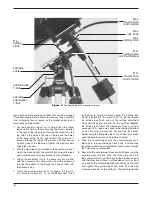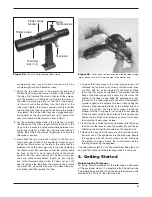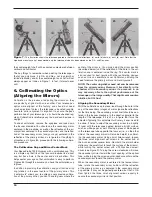
12
to see if the “dot” of the collimation cap is moving closer or
further away from being centered in the “ring” of the primary
mirror. When you have the dot centered as much as pos-
sible in the ring, your primary mirror is collimated. The view
through the collimation cap should resemble Figure 8e.
A simple star test will tell you whether the optics are accu-
rately collimated.
Star-testing the telescope
When it is dark, point the telescope at a bright star and accu-
rately center it in the eyepiece’s field of view. Slowly de-focus
the image with the focusing knob. If the telescope is correctly
collimated, the expanding disk should be a perfect circle
(Figure 12). If the image is unsymmetrical, the scope is out
of collimation. The dark shadow cast by the secondary mirror
should appear in the very center of the out-of-focus circle,
like the hole in a donut. If the “hole” appears off-center, the
telescope is out of collimation.
If you try the star test and the bright star you have selected is
not accurately centered in the eyepiece, the optics will always
appear out of collimation, even though they may be perfectly
aligned. It is critical to keep the star centered, so over time
you will need to make slight corrections to the telescope’s
position in order to account for the sky’s apparent motion.
7. using Your telescope—
Astronomical Observing
Choosing an Observing Site
When selecting a location for observing, get as far away as
possible from direct artificial light such as street lights, porch
lights, and automobile headlights. The glare from these lights
will greatly impair your dark-adapted night vision. Set up on
a grass or dirt surface, not asphalt, because asphalt radiates
more heat. heat disturbs the surrounding air and degrades
the images seen through the telescope. Avoid viewing over
rooftops and chimneys, as they often have warm air currents
rising from them. Similarly, avoid observing from indoors
through an open (or closed) window, because the tempera-
ture difference between the indoor and outdoor air will cause
image blurring and distortion.
If at all possible, escape the light-polluted city sky and head
for darker country skies. You’ll be amazed at how many more
stars and deep-sky objects are visible in a dark sky!
“Seeing” and transparency
Atmospheric conditions play a huge part in quality of view-
ing. In conditions of good “seeing”, star twinkling is minimal
and objects appear steady in the eyepiece. Seeing is best
overhead, worst at the horizon. Also, seeing generally gets
better after midnight, when much of the heat absorbed by the
Earth during the day has radiated off into space. Typically,
seeing conditions will be better at sites that have an altitude
over about 3000 feet. Altitude helps because it decreases
the amount of distortion causing atmosphere you are looking
through.
A good way to judge if the seeing is good or not is to look at
bright stars about 40° above the horizon. If the stars appear
to “twinkle”, the atmosphere is significantly distorting the
incoming light, and views at high magnifications will not
appear sharp. If the stars appear steady and do not twinkle,
seeing conditions are probably good and higher magnifica-
tions will be possible. Also, seeing conditions are typically
poor during the day. This is because the heat from the Sun
warms the air and causes turbulence.
Good “transparency” is especially important for observing
faint objects. It simply means the air is free of moisture,
smoke, and dust. All tend to scatter light, which reduces an
object’s brightness.
One good way to tell if conditions are good is by how many
stars you can see with your naked eye. If you cannot see
stars of magnitude 3.5 or dimmer then conditions are poor.
Magnitude is a measure of how bright a star is, the brighter a
star is, the lower its magnitude will be. A good star to remem-
ber for this is Megrez (mag. 3.4), which is the star in the ‘Big
Dipper’ connecting the handle to the ‘dipper’. If you cannot
see Megrez, then you have fog, haze, clouds, smog, or other
conditions that are hindering your viewing (Figure 13).
Cooling the telescope
All optical instruments need time to reach “thermal equilib-
rium”. The bigger the instrument and the larger the tempera-
Figure 11.
The back end of the optical
tube (bottom of the primary
mirror cell). The three pairs of
collimation screws adjust the
tilt of the primary mirror.
Figure 12.
A star test will determine if a telescope’s optics are
properly collimated. An unfocused view of a bright star through the
eyepiece should appear as illustrated on the right if the optics are
perfectly collimated. If the circle is unsymmetrical, as in the illustration
on-the left, the scope needs collimation.
Out of collimation
Collimated
















